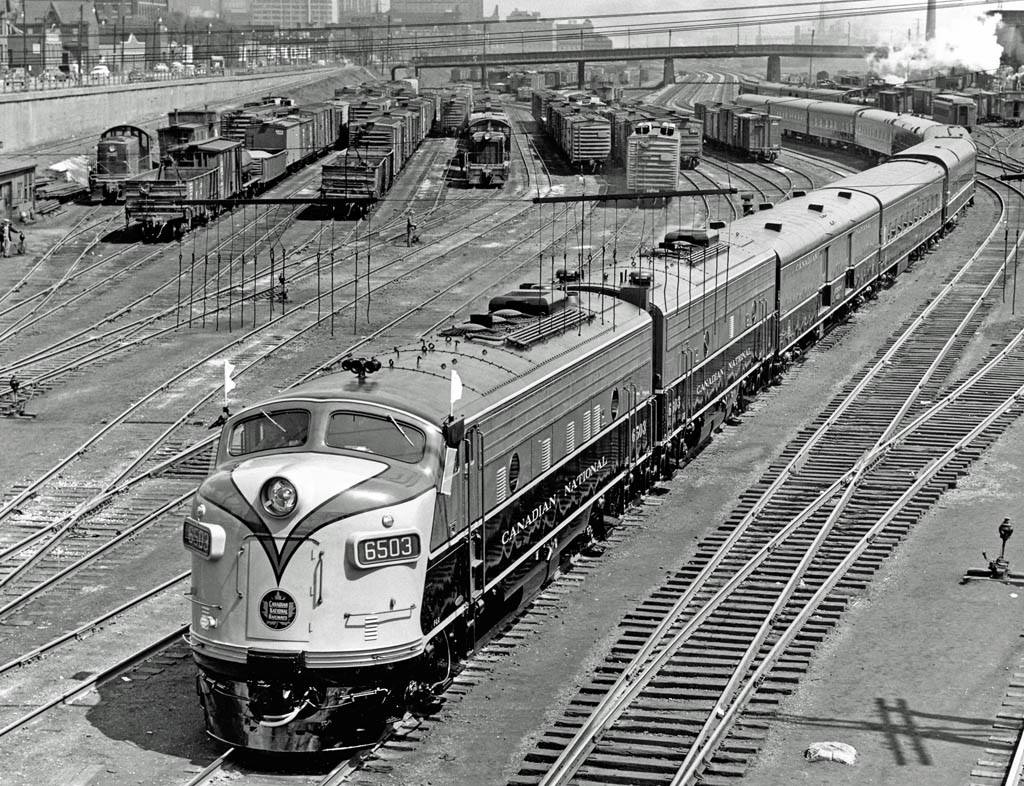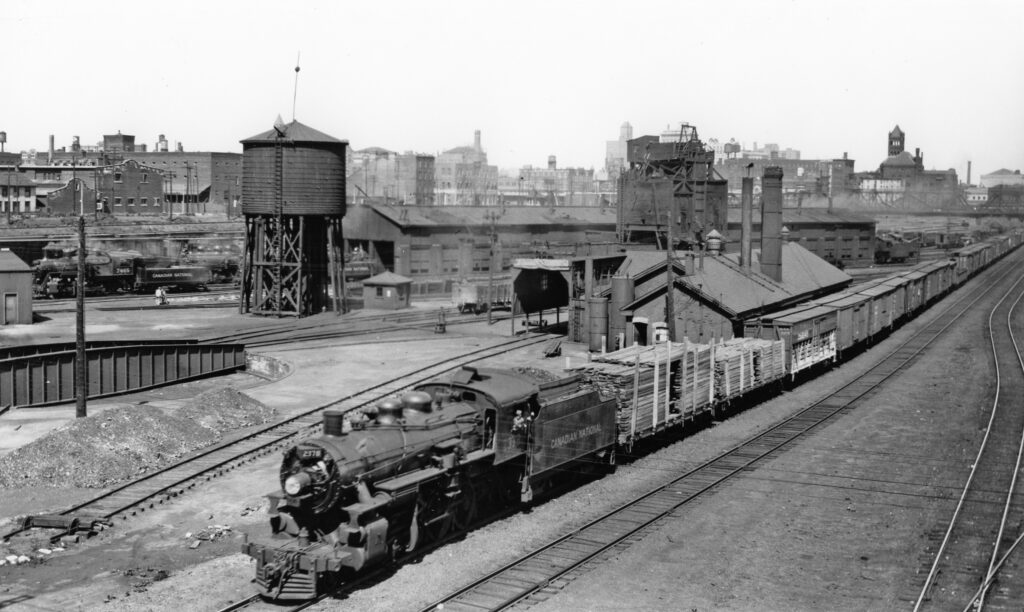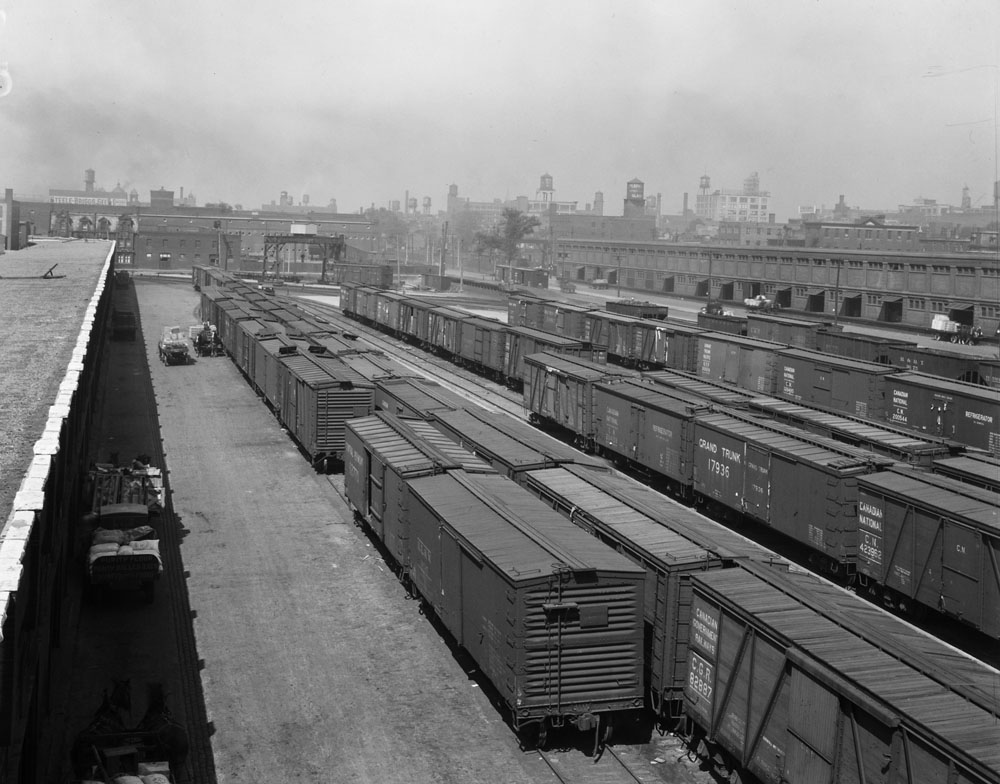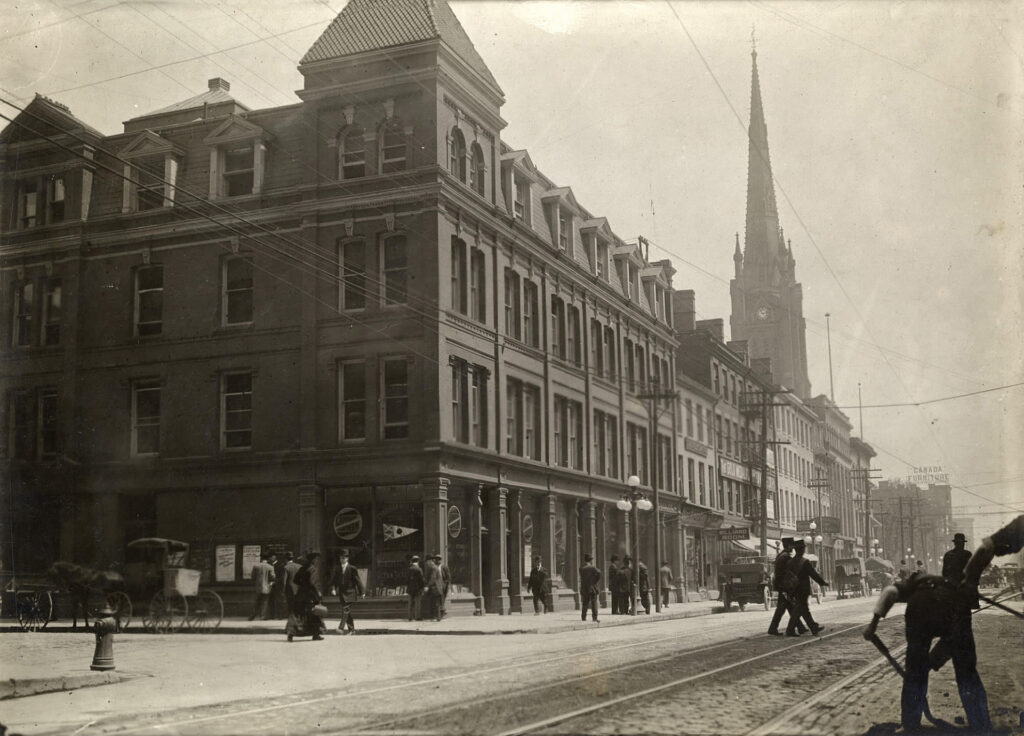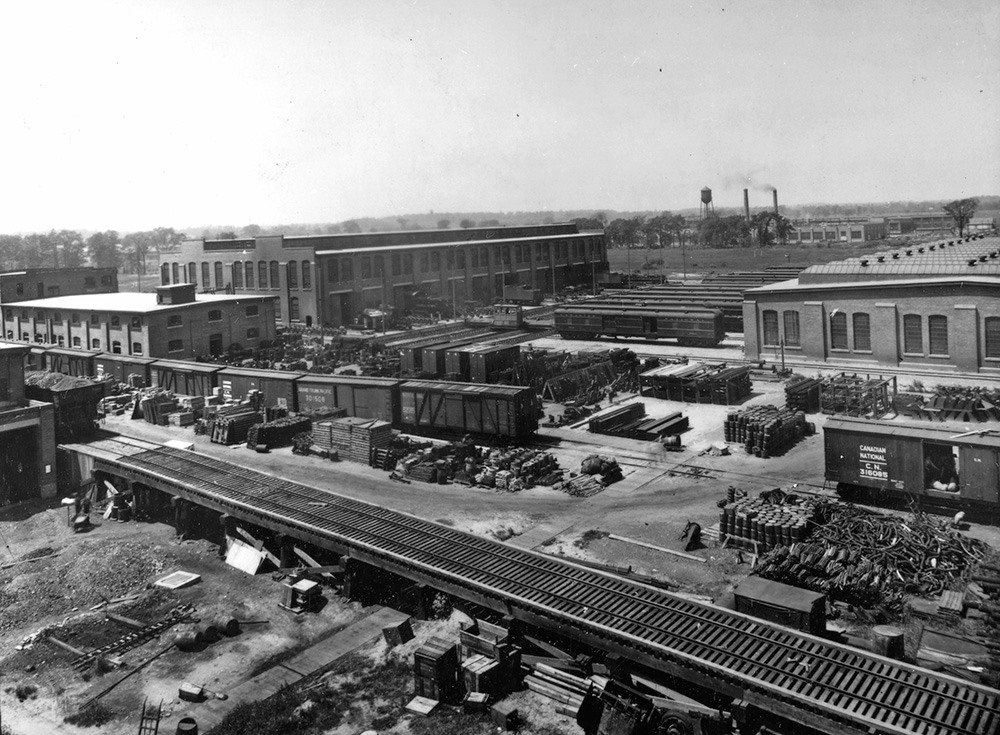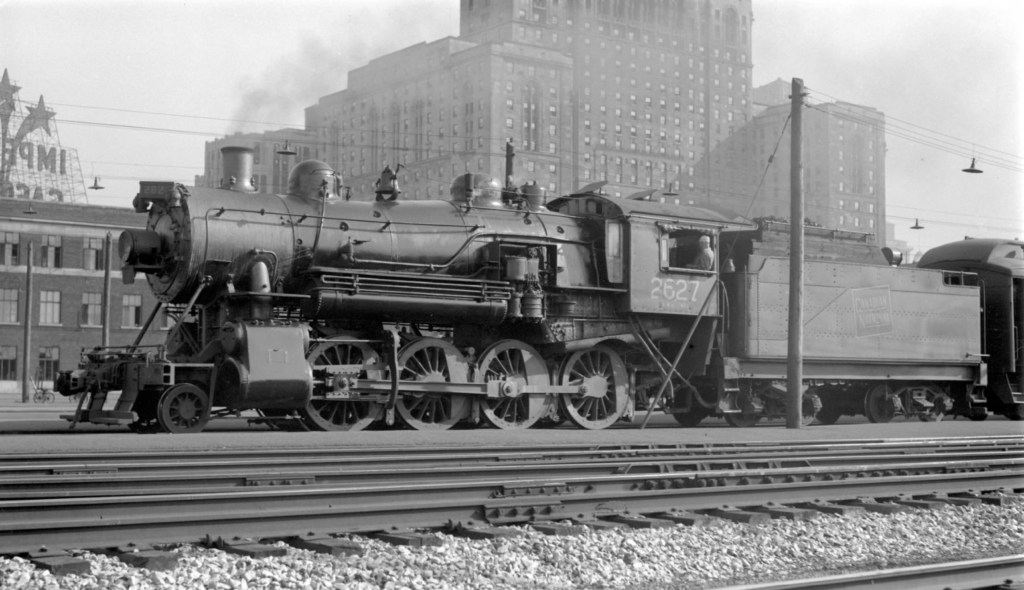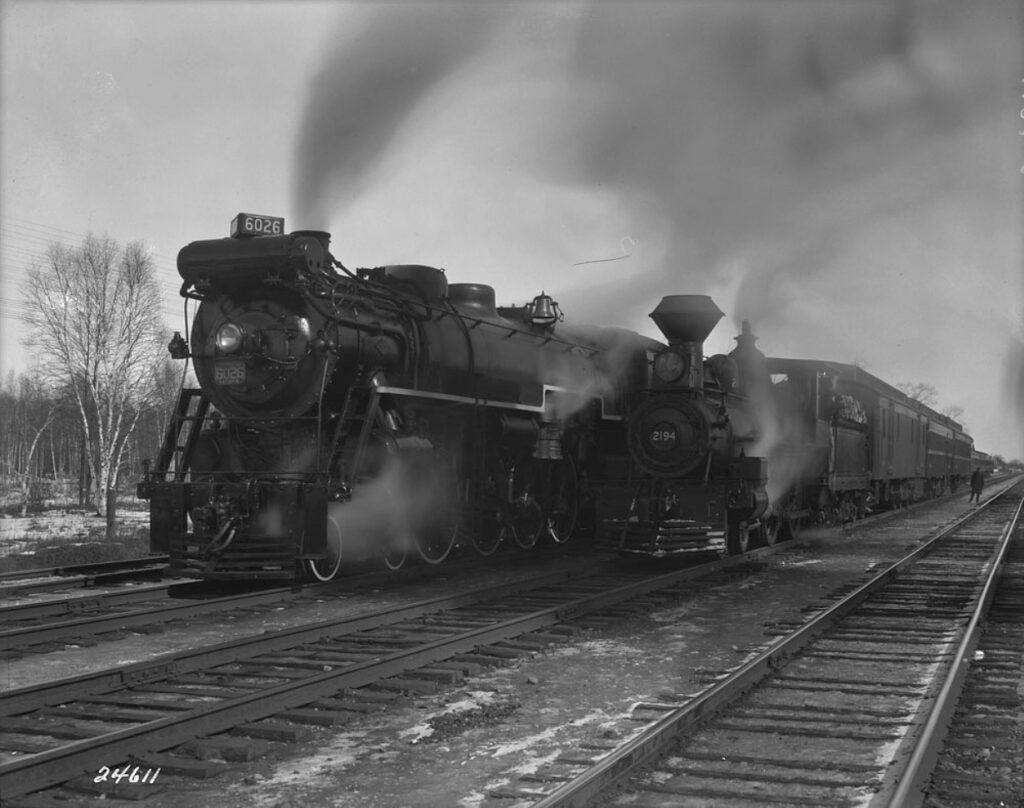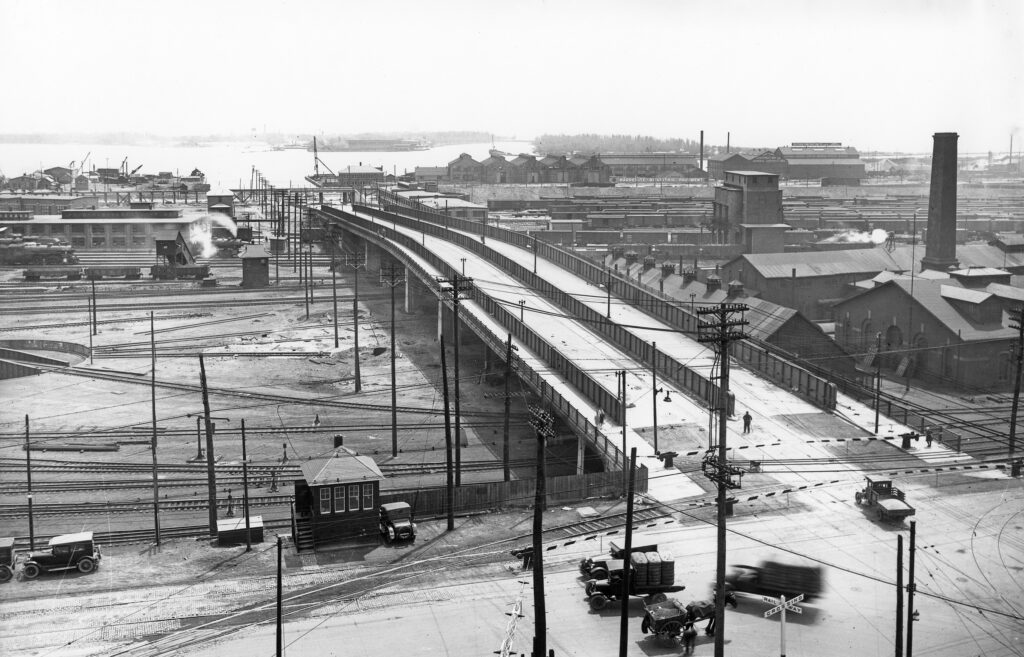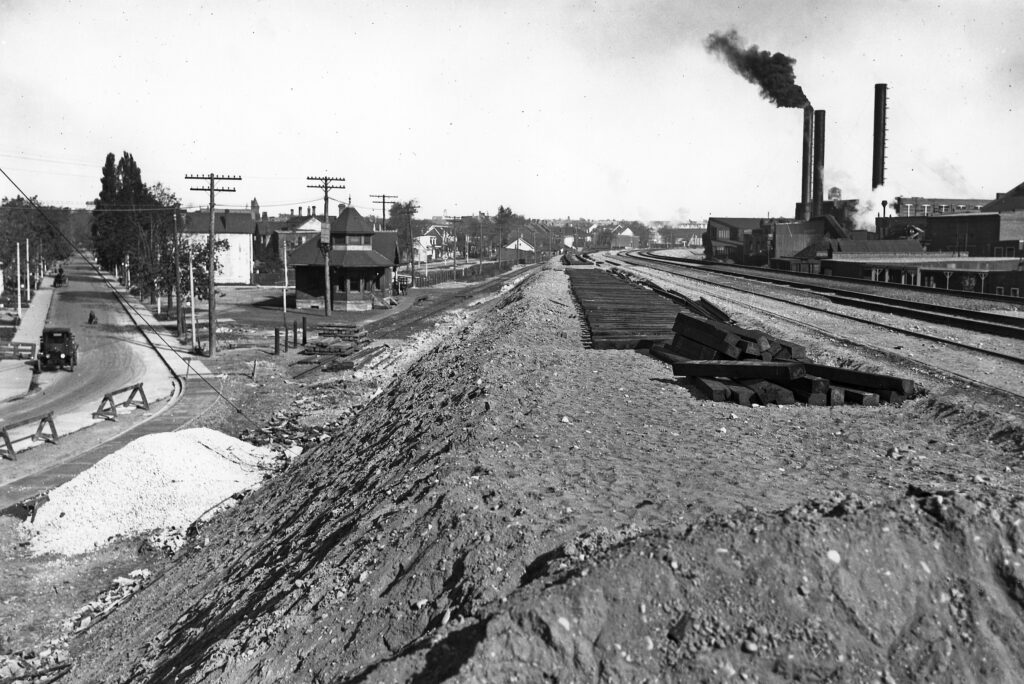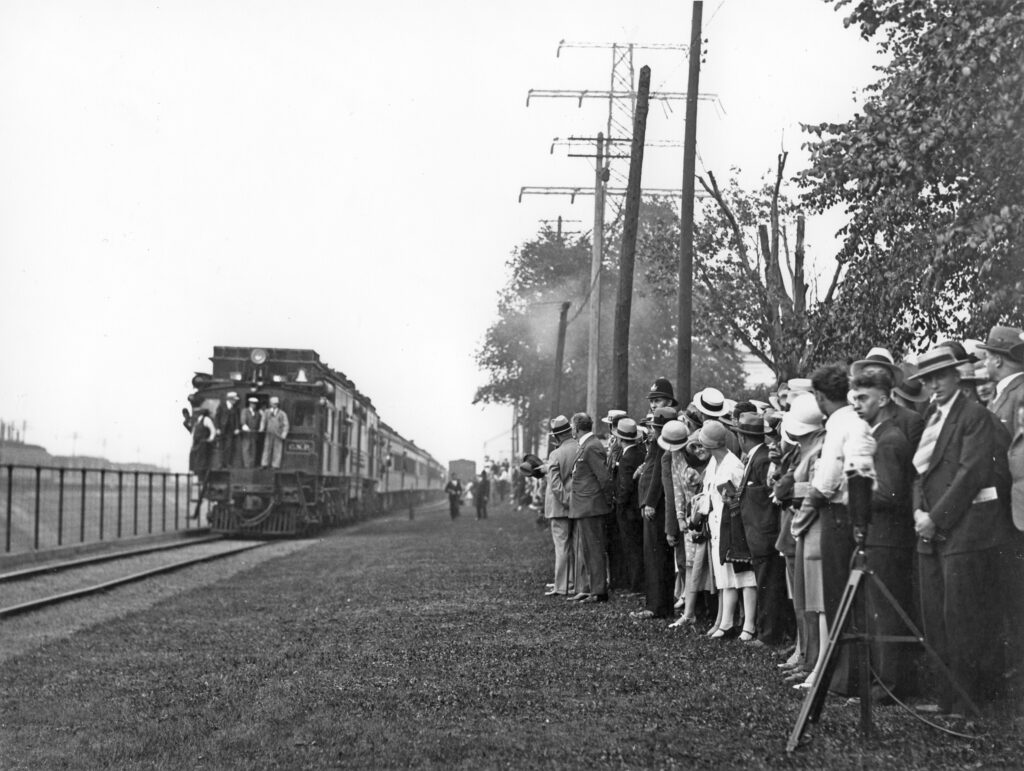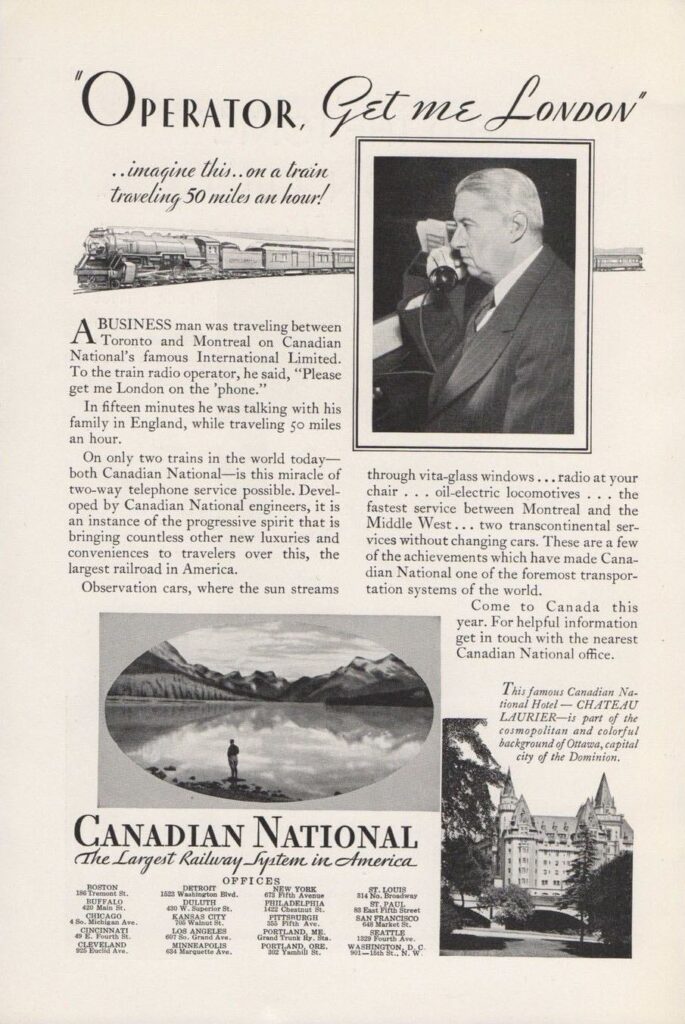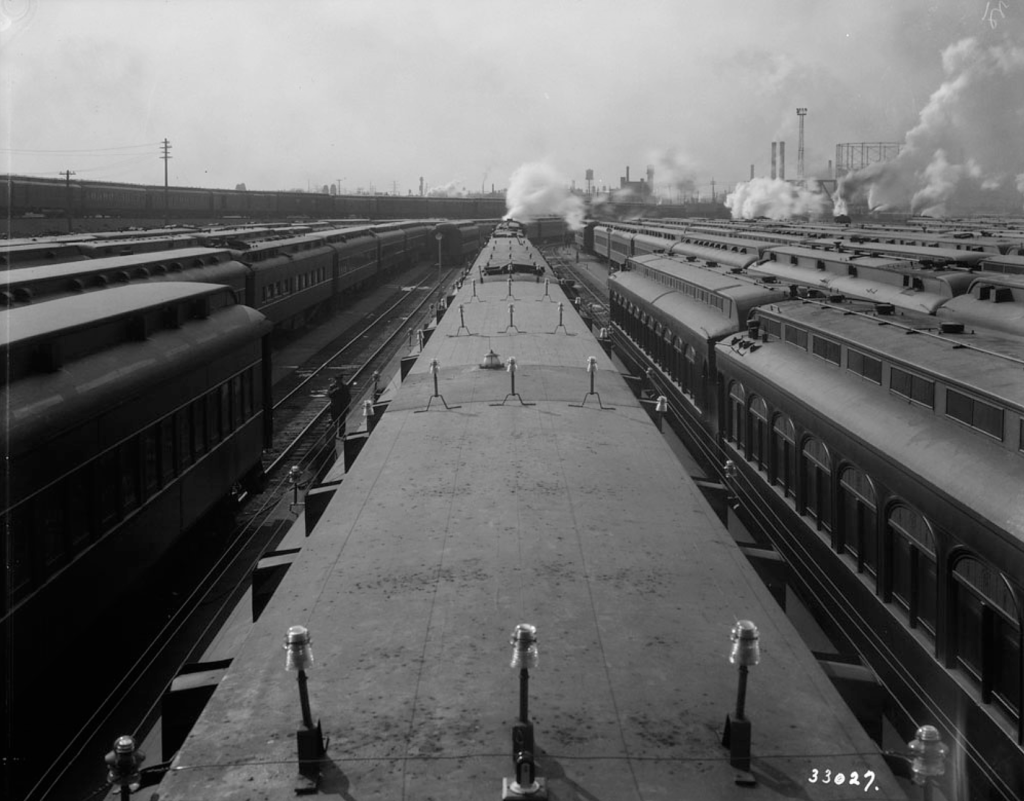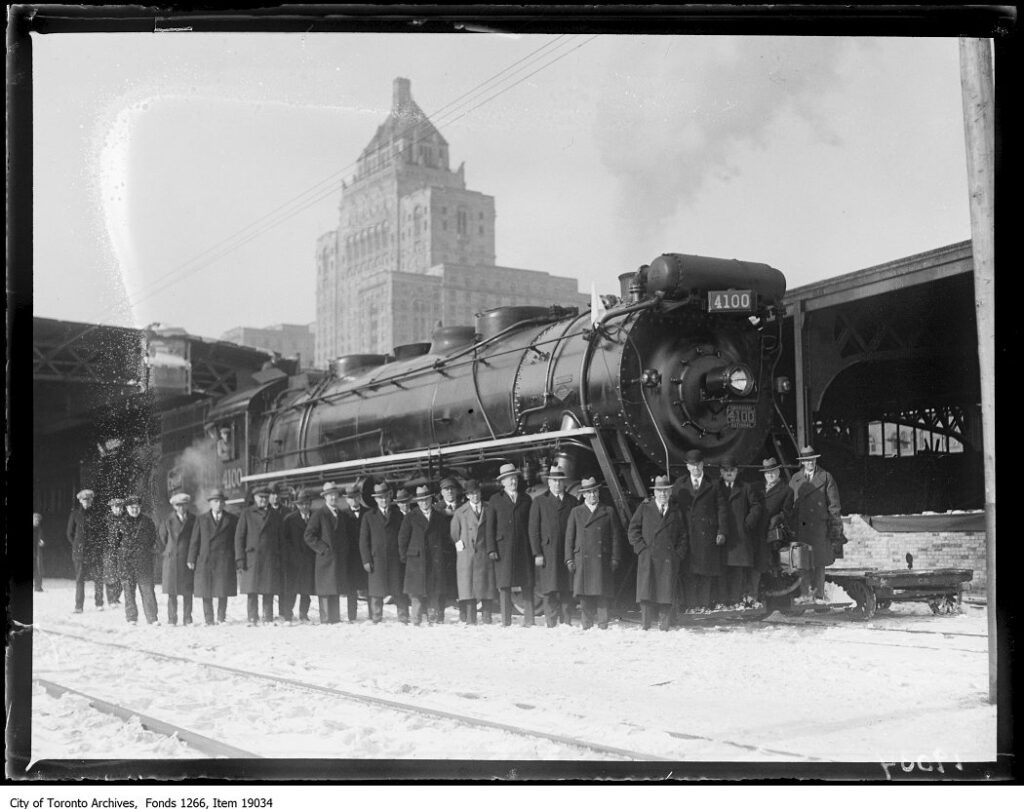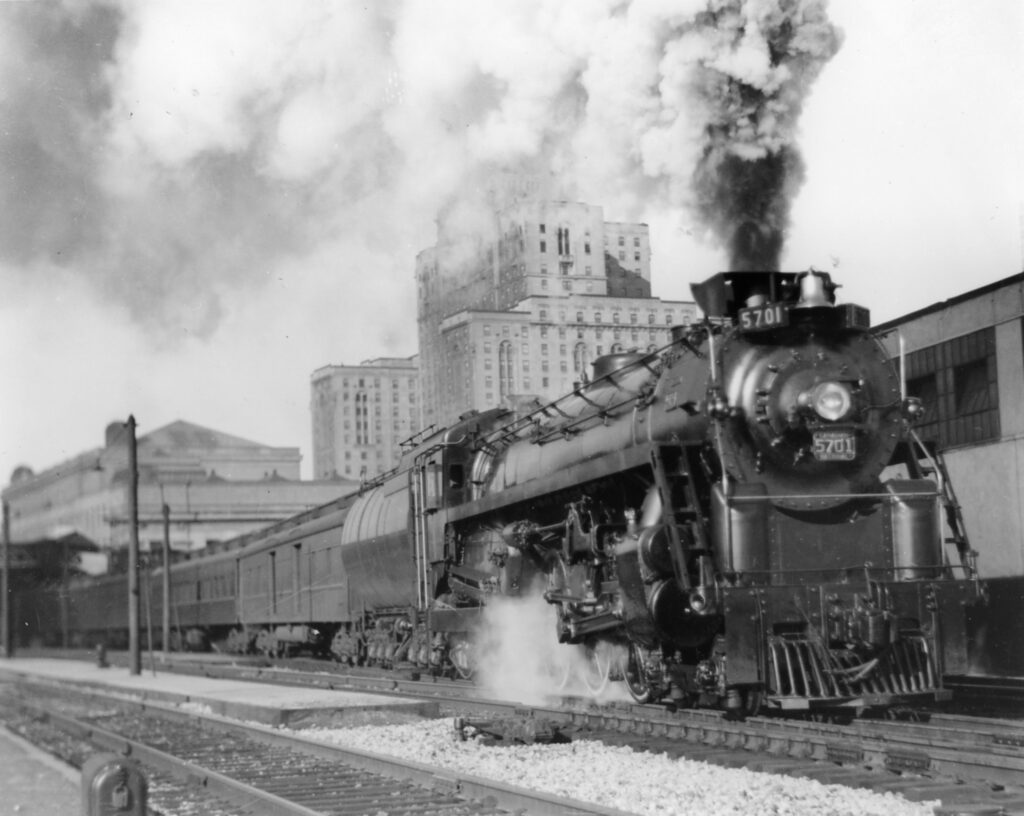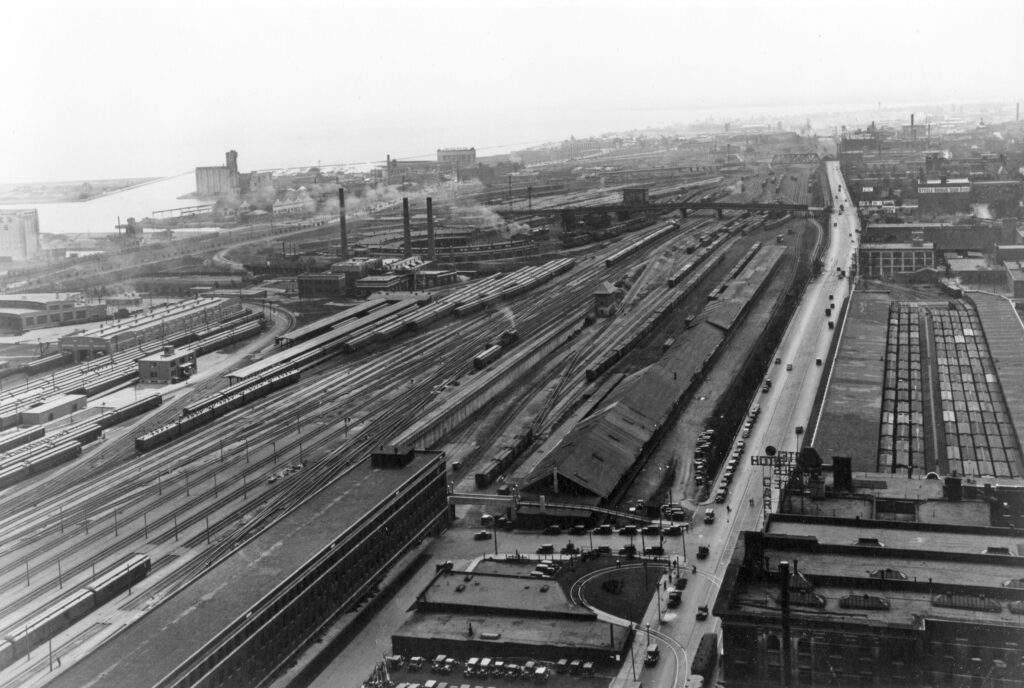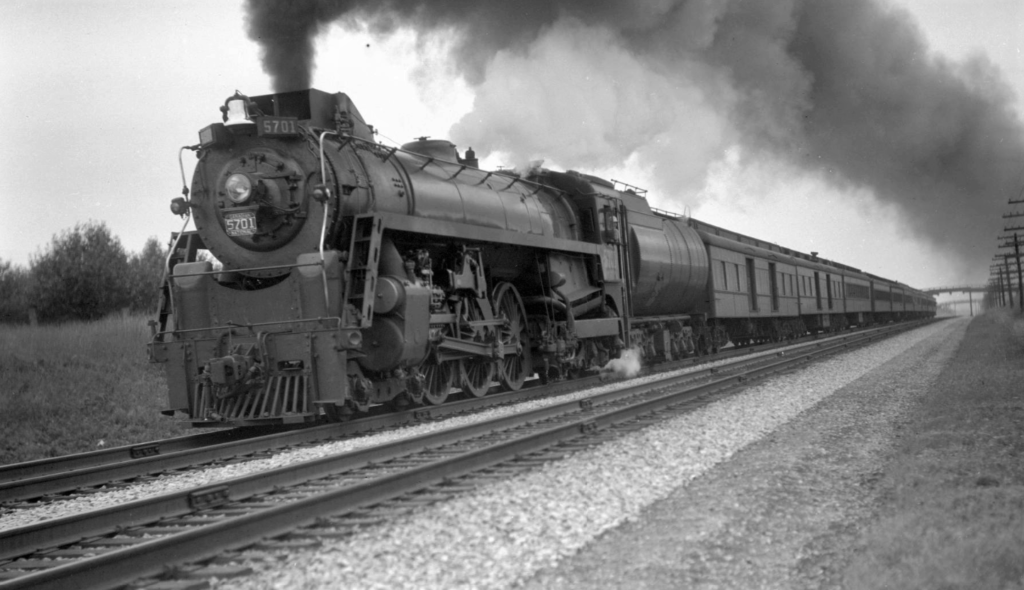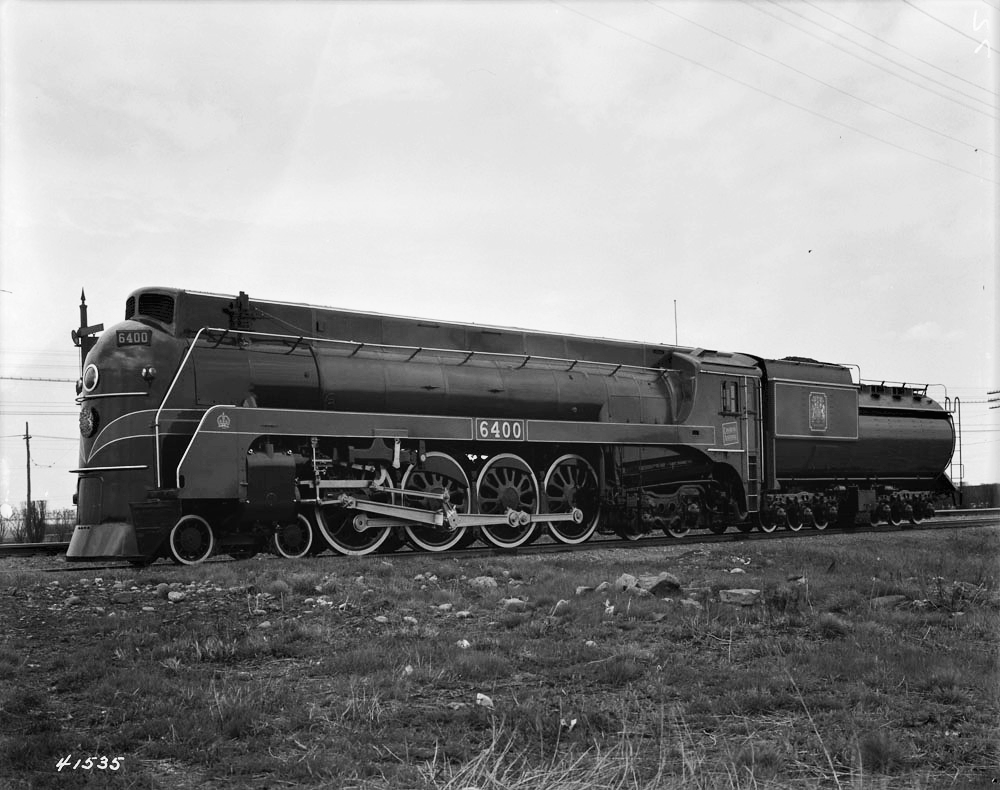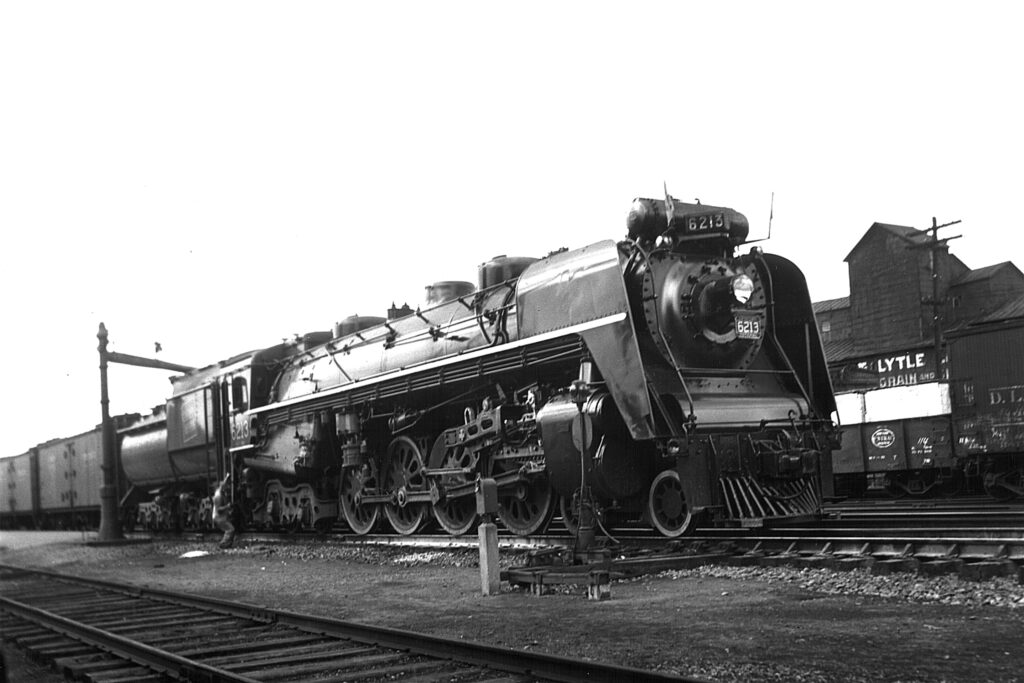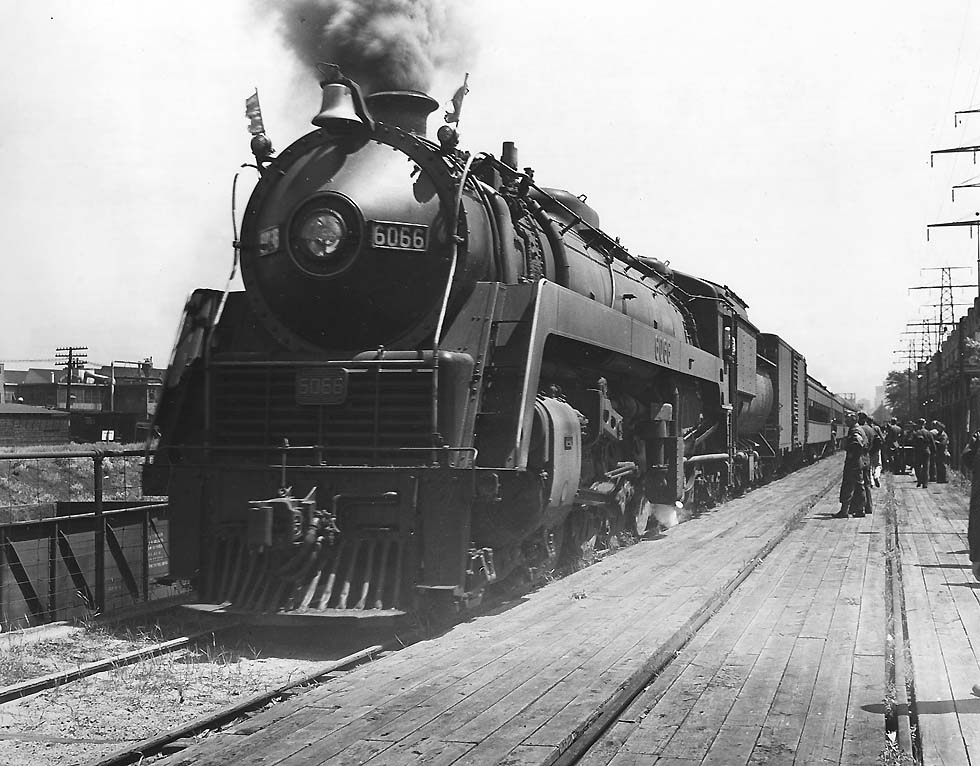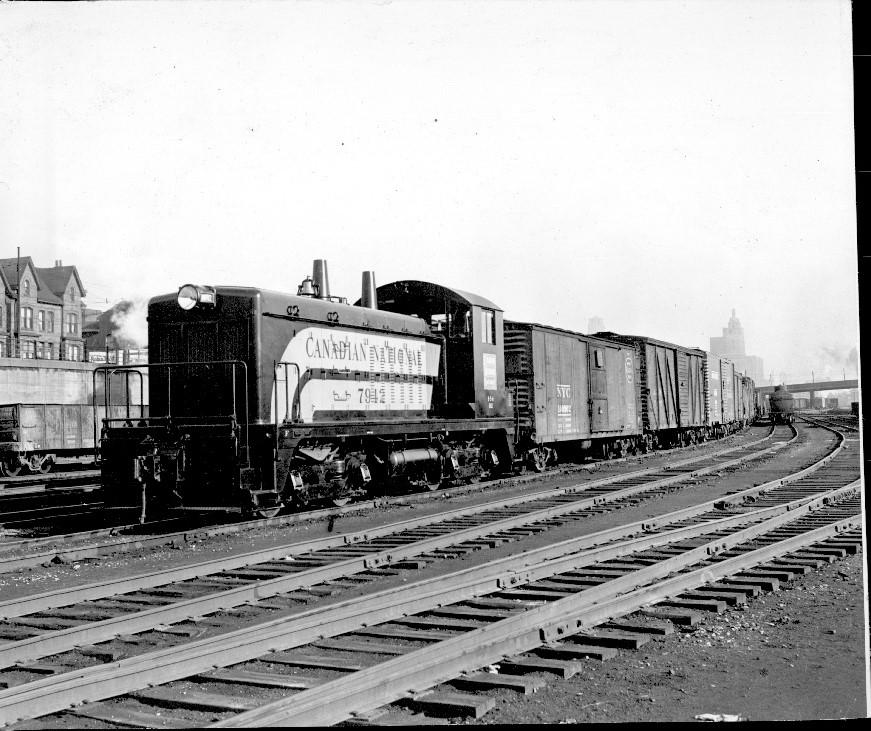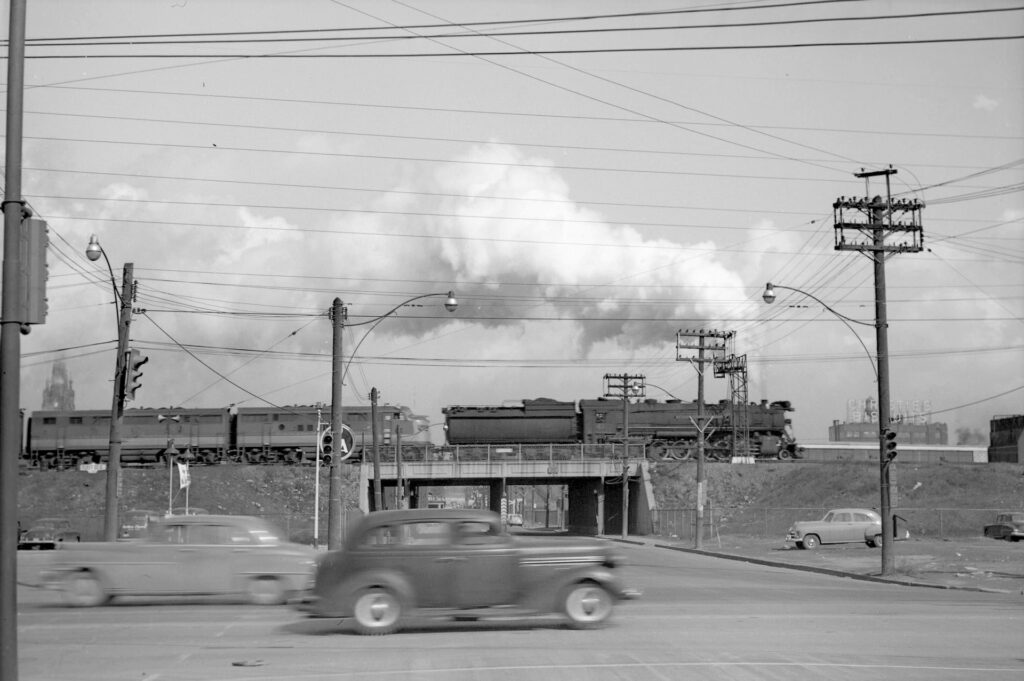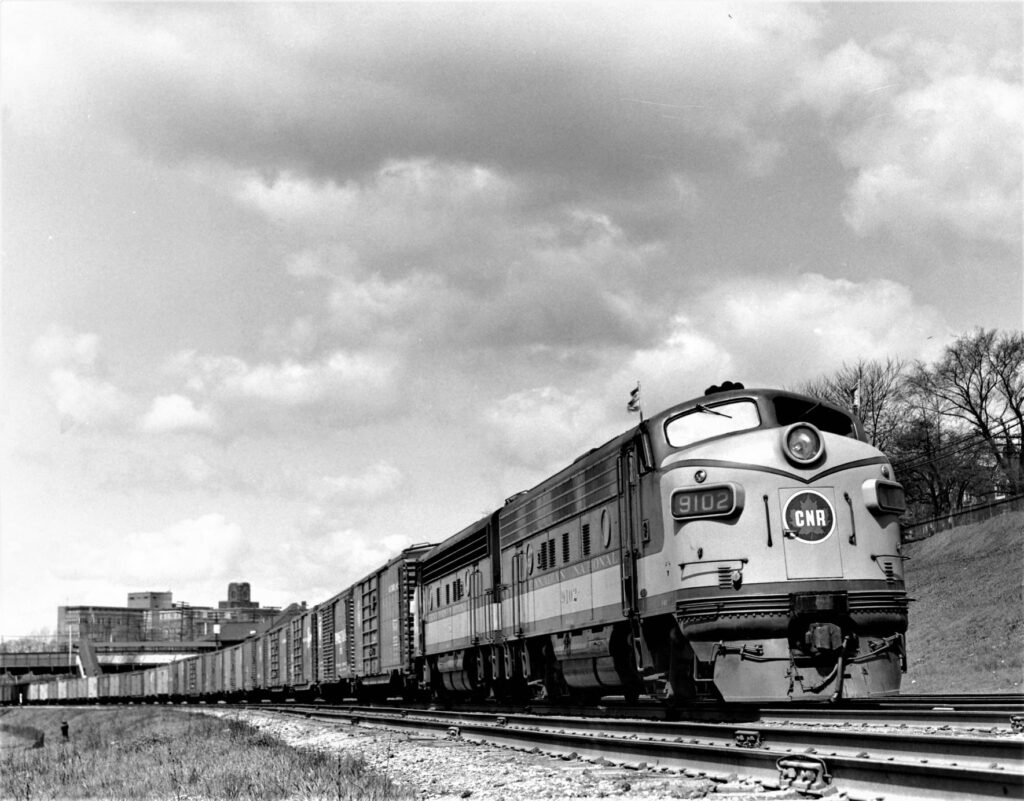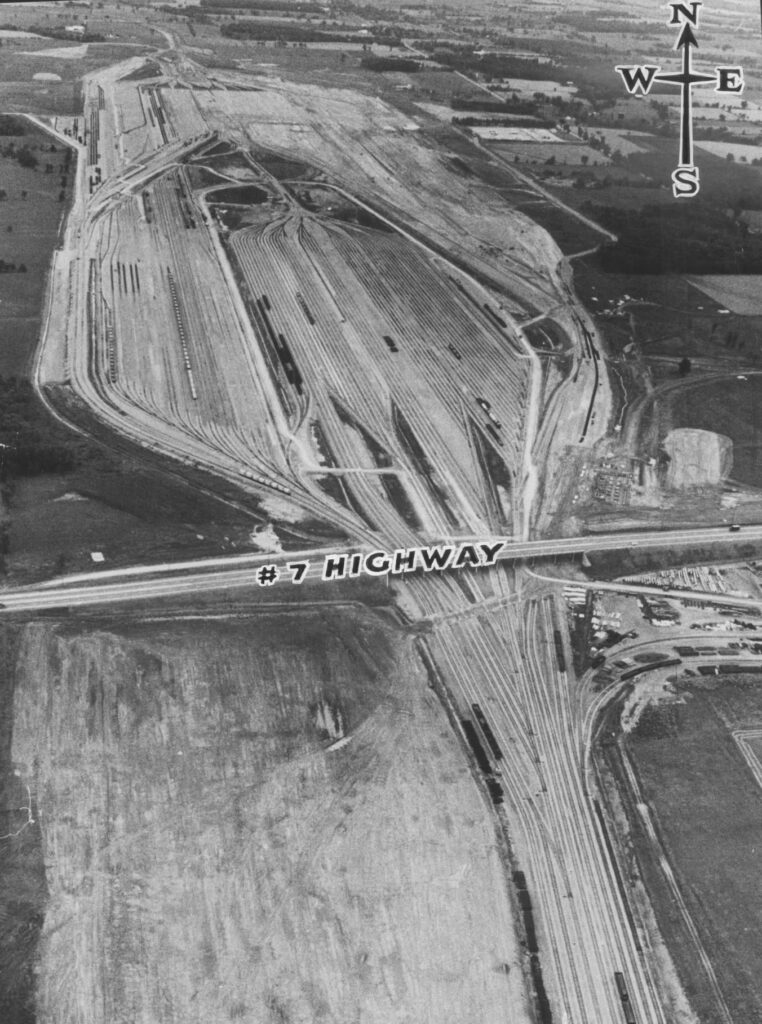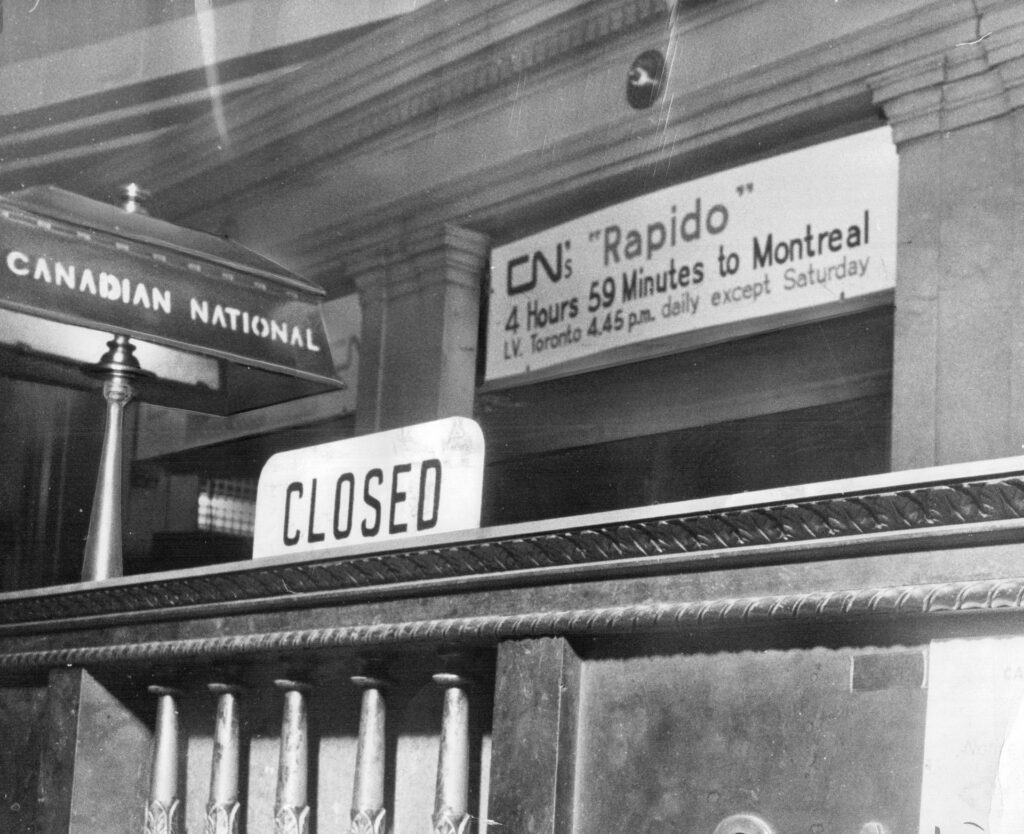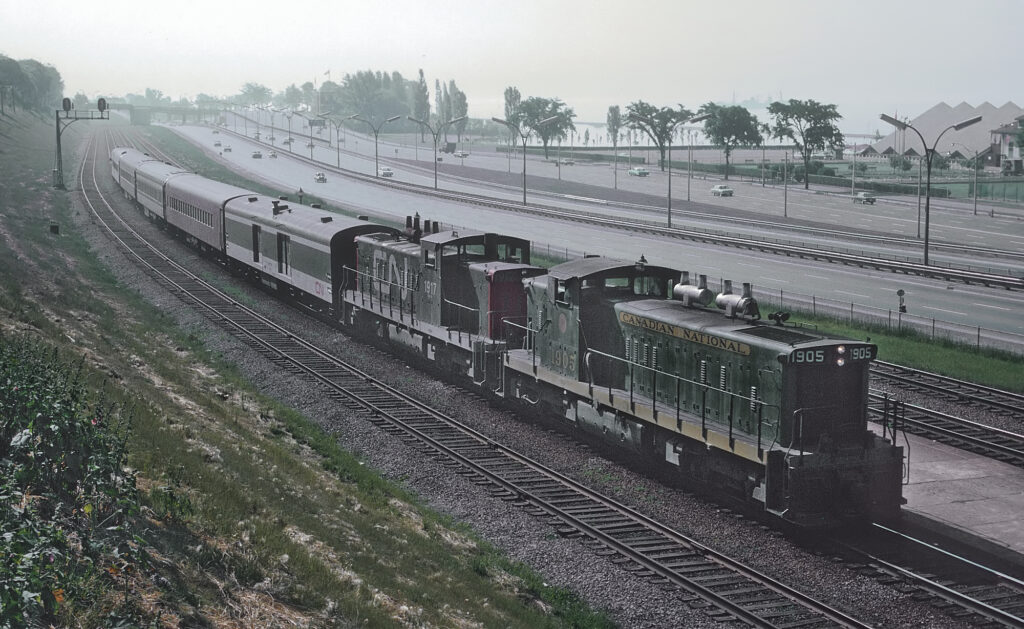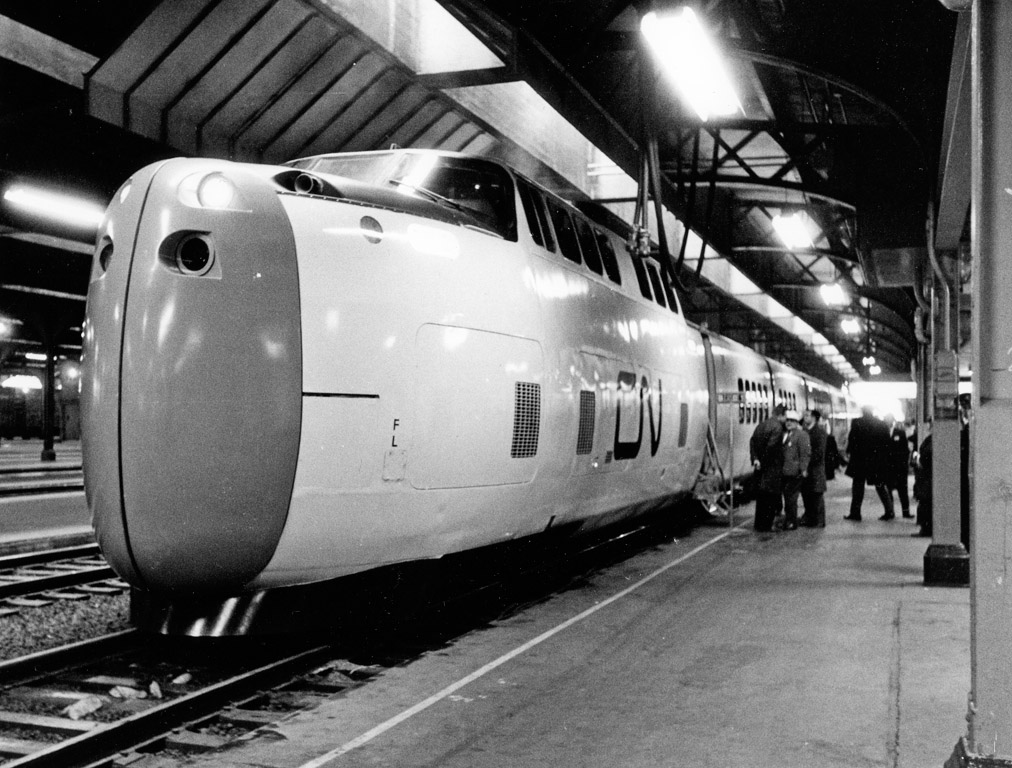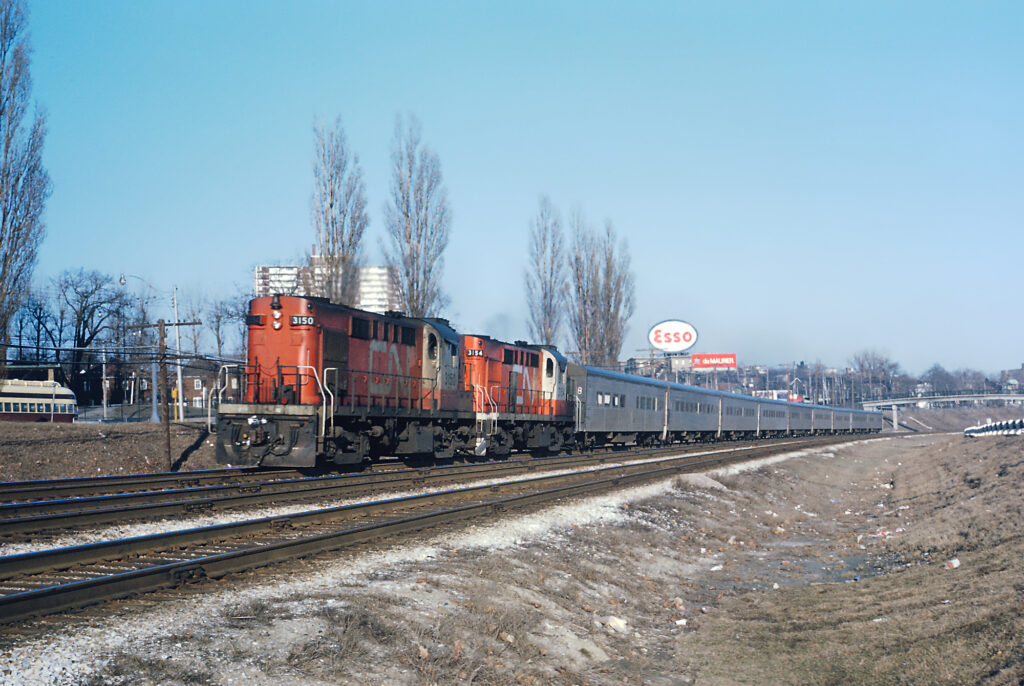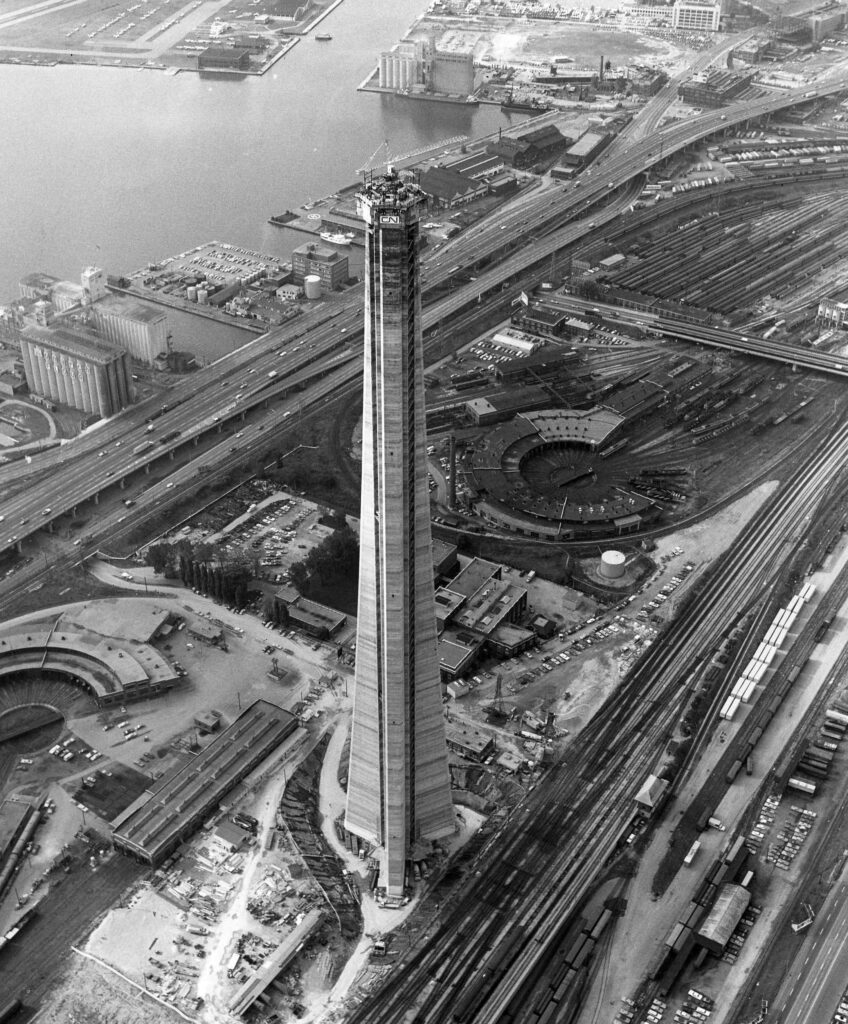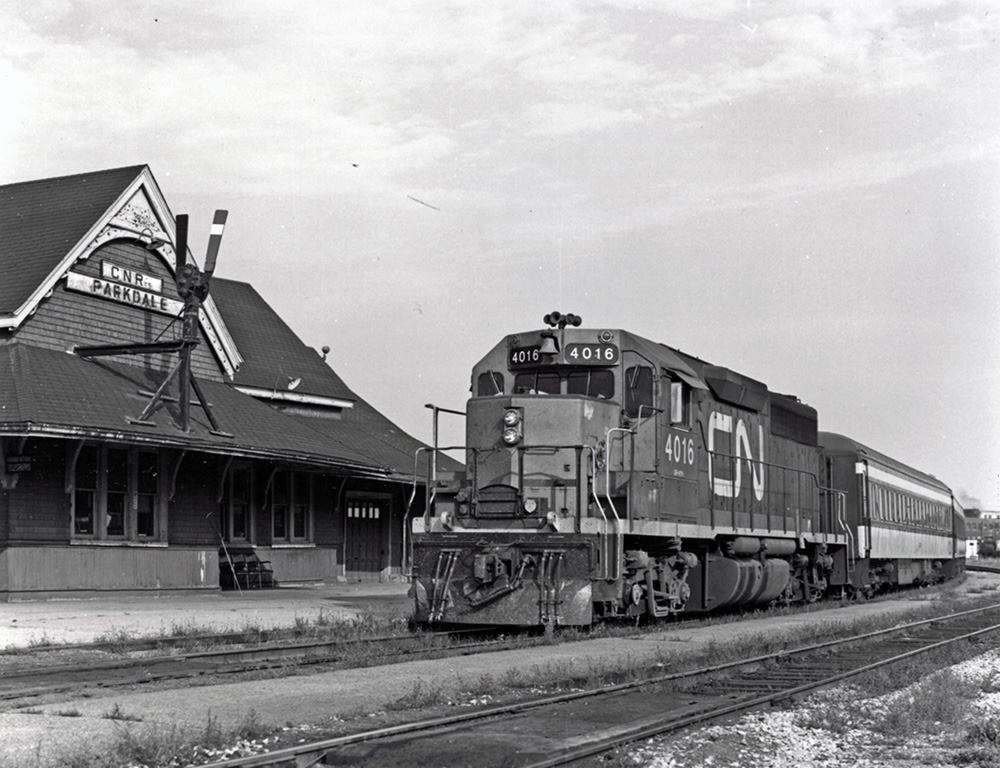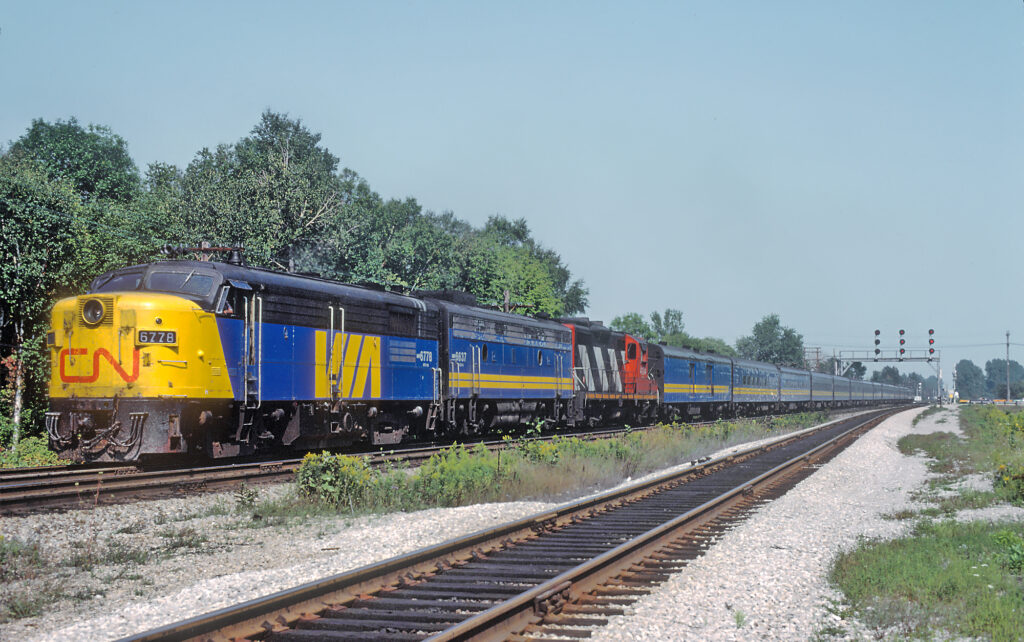Introduction
The Canadian National Railway was formed well after most of its contemporaries in Toronto. It was created as a federal crown corporation just after World War One to consolidate the faltering Canadian Northern Railway with the other railways already managed under the Canadian government. Shortly thereafter the CNR was similarly used to gain control of the failing Grand Trunk, quickly making it the largest railway in the country in terms of mileage – a title it still holds to this day. Canadian National encountered many challenges in its first few decades of operation: it came at a time of global socioeconomic and political unrest, and when nationalizing the railway industry was necessary to meet the crushing demands of wartime production. It quickly organized itself as a major player in the railway industry while dealing with the impacts of the Great Depression and World War Two. Like all major freight railways in North America, CN struggled to stay relevant in the age of automobile and air travel after the 1940’s. After spinning off its passenger service as VIA Rail in 1977, CN followed its rivals in exclusively embracing freight service. After privatization under the Chrétien government in 1995, the railway celebrated its hundredth anniversary in 2019.
Canada’s Railway Bust
By the time World War One began, the Canadian Government managed a total of four railway companies. The earliest of them was the Intercolonial Railway, founded in 1872 to run between the Grand Trunk in Montreal and the port of Halifax. It came about because of Canada’s confederation a few years earlier in 1867 with the purpose of providing rail access to an ice-free Atlantic port entirely within Canadian territory. The narrow-gauge Prince Edward Island Railway fell into federal hands soon afterward in 1874 due to financial issues. The colony of PEI had initially refused to join Canada in 1867, but the cost of constructing the railway threatened to bankrupt them. This predicament helped to persuade the colony to join Canada in 1873, after which the railway was nationalized. The third came a few decades later and for very different reasons than the previous two. The Hudson Bay Railway was formed by the Canadian government in 1910 to finish an uncompleted section of the Canadian Northern Railway. The latter built a line from Manitoba to The Pas with plans to reach Hudson Bay but refused to go further without government assistance. Due to difficult terrain and complications related to World War One, the Hudson Bay Railway was not completed until 1929.
The last, and perhaps the largest of Canada’s state-owned railways was the National Transcontinental Railway. When the Grand Trunk Railway was constructing their own line to the west coast, the board of directors wished to only assume the financial risks associated with the portion west of Winnipeg. They made a deal with the government to receive federal funding for their portion, while the section east of Winnipeg would be built and funded entirely by the federal government under an entity called the National Transcontinental Railway. After completion, this section was to be merged into the Grand Trunk. However, this deal went awry once the line was opened in 1914. The Grand Trunk found itself financially unable to absorb the National Transcontinental and reneged on its commitment. This occurred at the tail end of the railway boom in Canada, and the subsequent decline would ultimately set the stage for the formation of Canadian National.
As it became clear the Grand Trunk had no intentions of taking over the National Transcontinental, the federal government sought to consolidate its railways under one entity. This was done in 1915 with the formation of the Canadian Government Railways, which quickly began purchasing some newer and more powerful locomotives to replace the aging fleets of its constituent railways. By this point, the nationalization of railways was becoming more common in the western world. As World War One began the previous year, the countries involved focused their efforts on weapons manufacturing and logistics. Britain nationalized its railways the same year the war began in 1914. The United States Railroad Administration (USRA) was formed a few years later in 1917 as the managing body for the system of railroads that had been nationalized by the U.S. government, all for the purpose of streamlining their operations to meet the crushing demands of wartime. To this end, they would even standardize locomotive and rolling stock designs under the USRA standard. While done primarily out of necessity, nationalization was also motivated by a desire to operate railroads as a public service rather than a boon for shareholders.
The railway bust in Canada further intensified around the end of the war. The Canadian Northern faced mounting financial issues underscored by debts to the federal government. For them, going into receivership would have disastrous consequences especially given the context of wartime. Most notably it had the potential to render the Canadian Bank of Commerce insolvent as they had thoroughly bankrolled the railway. To prevent this from happening the government gained a controlling interest in the company on August 1st, 1917, ensuring its operations could continue unimpeded. On September 6th, 1918, company directors William Mackenzie and Donald Mann were replaced by a new board of directors appointed by the government. At the Toronto Exhibition directors’ luncheon three days later, then-Prime Minister Sir Robert Borden was quoted as saying the following:
“The total railway mileage owned by [the government of] Canada is very large, comprising nearly 14,000 miles, and reaching from the Atlantic to the Pacific. All the lines included in this mileage should be operated as one system, and under one management. This system should not be administered by a department of the government, but it should be connected as soon as practicable with steamship lines on both the Atlantic and the Pacific, and last, but not least, its operation should be kept absolutely free from party political interference. For these reasons, and for this purpose, the Canadian Northern Railway System’s board will be reconstituted in the immediate future”.
In addition to trackage belonging to the Canadian Government Railways, the federal government now owned and operated the over 17,000 kilometres (11,000 miles) of track belonging to Canadian Northern. These systems were much too large to manage and fund separately, and efforts to combine the two under a single entity would begin soon afterward. The Canadian National Railways was born a few months later by an order-in-council on December 20th and incorporated on June 6th, 1919, though its constituent railways would continue to exist on paper until January 20th, 1923.
Simultaneously, the economic conditions that prevented the Grand Trunk from taking over the National Transcontinental intensified. They defaulted on their loans from the government in 1919, and their Grand Trunk Pacific subsidiary would be nationalized that year on March 7th. The Grand Trunk’s shareholders tried to use legal means to prevent the same from happening to the parent company, but this would only delay the inevitable. On the same date Canadian National officially formed in 1923, the Grand Trunk and all of its subsidiaries were merged into it, adding an additional 12,800 kilometers (7,950 miles) of track to the Canadian National system.
Picking Up The Pieces
Sir Henry Thornton became president of the yet-to-be-incorporated Canadian National in 1922, replacing David Hannah. Thornton had previously managed the Long Island Railroad and worked for several other railroad companies in the United States and Britain. When he joined Canadian National, their system was made up of a vast number of duplicate lines that had belonged to its predecessors, as well as a fleet of outdated and aging equipment that would have to be replaced. In addition to modernizing the railway, the duplicate lines would need to be quickly addressed to ensure the railway could operate as a cohesive unit. The Canadian Northern line east of Toronto to Napanee was abandoned gradually over the next two decades, save for a handful of areas still used to access industries. The former Grand Trunk line was chosen as the preferred right-of-way as it ran somewhat parallel but was more direct and served several larger communities than the Canadian Northern did. The entire length of it had already been double tracked as well, allowing for a higher volume of trains. Some junctions that previously belonged to Canadian National’s predecessors, such as the diamond in Washago, Ontario, were vastly reworked with new connecting tracks to allow trains to switch from one line to the other.
Administrative changes began almost immediately, with Thornton moving the CNR offices from the former Canadian Northern building in Toronto to the former Grand Trunk building in Montreal in 1923. Montreal would remain the location of Canadian National’s head offices up to the present day, though they now occupy a different building. A modified version of the Grand Trunk’s “tilted wafer” logo was adopted by the company in 1923, a somewhat ineffective attempt at differentiating Canadian National’s brand from its predecessors. The slogan “The National Way” was adopted almost immediately though it was soon replaced. Thornton became known for his relatively good treatment of employees, vastly deviating from the behaviour of private railroad companies during the previous century. This was an important position for the railway to take given the labour rights movement occurring in Canada at the time, especially in the wake of the 1919 Winnipeg General Strike.
Thornton then began an effort to aggressively compete with Canadian Pacific directly, which mostly manifested with the passenger service offered between Toronto and Montreal. This was done through the replacement older equipment used on that route with new ones that could operate at higher speeds. A total of twenty-one 4-8-2 Mountain type steam locomotives were purchased and delivered from the Canadian Locomotive Company in Kingston, Ontario in 1923. This was followed by an additional fifteen in 1924, and another five that were built by the Baldwin Locomotive Works in Eddystone, Pennsylvania in 1925. These engines were significantly larger and more powerful than most of the CN fleet at the time. Some of their first assignments were on the International Limited, one of Canadian National’s express passenger trains that ran between Montreal and Chicago. The rest of the consist for the International Limited was also updated with all-steel passenger coaches. One of the more notable achievements of the CNR under Thornton was the establishment of a radio network for passengers to use while on a moving train. This network was later used by the Canadian Broadcasting Corporation in its early years. Perhaps the most revolutionary piece of technology to be developed by CN for passenger comfort was the two-way train phone in 1929, the first of its kind anywhere in the world. It used a combination of telephone and radio technology to allow passengers to make phone calls on par with any regular telephone while on a moving passenger train. It was tested by CN just north of Toronto on at least one occasion before seeing use on the International Limited. Unfortunately, the economic effects of the Great Depression led to the removal of the train phone in 1931 as it was too costly to maintain.
The Toronto area in particular saw its fair share of changes while Thornton oversaw the railway. The city’s main rail corridor was being actively reshaped by the Grand Trunk and Canadian Pacific prior to World War One, but the war significantly delayed progress due to labour and material shortages. The new Union Station headhouse had been completed in the Grand Trunk era, though the railways and the city had not reached an agreement yet as to who would be responsible for separating the grade of the rail corridor from the roads it crossed. In 1924 it was decided that the railways would be responsible for raising the corridor above the surrounding roads. Work on this monumental task began the following year, involving significant amounts of earth dumped where the new tracks were to be laid. Simultaneously, Thornton sought to consolidate the engine servicing terminals in the Toronto area to a single location as the ones CN inherited had varying degrees of adequacy and were spread out across the city. The newer locomotives were often too large for the turntables of these smaller engine facilities, some of which dated back 70 years. The former Canadian Northern shops in Leaside were completed in 1919 and could be considered the most state-of-the-art in the city at the time, but it would see little use after Canadian National began consolidation efforts. Mostly, the railway’s obsolete locomotives and rolling stock were scrapped there during its few years of operation. The locomotive shop closed on March 31st, 1926, and operations were subsequently moved to Stratford. The roundhouse was closed several years later in 1934. Most of these buildings were torn down over the years, but the locomotive shop remains and has been converted into a grocery store.
Perhaps the most notable achievement of Canadian National during this period was their ownership of Canada’s first diesel-electric locomotives, nearly two decades before diesels would become more widely used in North America. Built in 1928 and 1929 respectively, the pair of units were initially meant to be joined together and operated as a single unit. On August 1st, 1929, they were used to pull the International Limited from Montreal to Toronto in 7 hours and 40 minutes. After arriving in Toronto, the train was moved to the display track of the Canadian National Exhibition. Efforts in dieselization would be stalled by the Great Depression, though this pair of diesel units would remain in service until 1946.
The Thornton era ended with the election of R. B. Bennett’s Conservative Party in 1930, as they accused Thornton of being a Liberal partisan and pointed out alleged improprieties in his expense account. The result was Thornton’s resignation in 1932, and the federal government subsequently reneged on a promised pension settlement. An MP described it as “the rawest deal any man ever received from the Government of Canada.” He died the following year on March 14th from pneumonia and complications from surgery, coincidentally on the same night he was to be honoured at a special dinner held by Canadian National’s unionized employees.
Cooperation during the Great Depression
Canadian National would enter the Great Depression on a relative high note, having opened Toronto’s new Union Station in 1927 and the elevated rail corridor in 1930. The new corridor was thoroughly tested with the heaviest locomotive available, one of Canadian National’s 2-10-2 Texas type steam engines delivered in 1924. It included three new interlocking towers to manually govern the switches and signals at Cherry Street, Scott Street, and John Street. A fourth tower called Cabin D which dated back to the 1890’s was kept and adapted into the new rail corridor’s interlocking system. Coinciding with the new corridor, the Spadina Roundhouse and coach yards were opened by Canadian National in 1927, officially referred to as the Toronto Locomotive and Car Facilities. Located approximately a kilometer southwest of Union Station, the facility was designed specifically to service passenger trains while between trips.
Canadian National took delivery of brand new 4-6-4 Hudson type steam locomotives in 1930, a wheel arrangement pioneered by the New York Central Railroad. These engines were designed specifically for fast passenger service on mainlines, and they would spend their first decade on Canadian National’s high-priority named passenger trains. The first locomotive in the series, number 5700, hauled its first revenue train out of Union Station in 1930. The train was greeted with much fanfare along the way to its destination of Windsor, Ontario, even becoming delayed by crowds in some cities. While Canadian National would ultimately consider these engines inferior to their 4-8-4 Northern types delivered in 1927 and 1929, the Hudsons were well suited to the shorter passenger train lengths used during the Great Depression. Only five Hudsons were built for Canadian National, and all would be assigned secondary duties once the depression ended and train lengths increased.
Passenger ridership over the entire Canadian National system had dropped by a staggering 45% by 1931, primarily due to the economic effects of the depression. Passenger service was already being adjusted or reduced in response by this point in time but maintaining the aggressive competition with Canadian Pacific that began under Thornton quickly became unsustainable. The two competitors were encountering similar issues that were exacerbated in areas that both railways provided similar service, most notably between Toronto and Montreal. A commission was formed to determine the best course of action in ensuring the continued success of Canada’s railways, and one of their recommendations was for both railways to coordinate their passenger trains over their respective routes between those cities. This agreement went into effect in 1932, but this was only a precursor to a much more radical change that would come about the following year. On April 2nd, 1933, Canadian National and Canadian Pacific began partially pooling their passenger trains between Montreal and Toronto as well as completely pooling their trains between Toronto and Ottawa. This means that affected trains might use the route of its competitor depending on which was faster or more profitable. Pool trains could also use a combination of equipment belonging to either railroad and tickets from either one were accepted. Remaining trains between Toronto and Montreal were pooled in March 1934, and the pool train agreement would remain in effect for many years after the end of the depression.
The depression was rounded off with a tour of Canada by the British royal family between May 17th and June 15th, 1939, which was facilitated through the cooperation of Canadian National and Canadian Pacific. While the latter handled the westward journey through Toronto, Canadian National would bring the train back through the city on June 6th. It was initially led by 4-8-2 Mountain type locomotive 6028 on this leg of the journey, and was briefly stopped short of Union Station by large crowds. 4-8-4 Northern type locomotive 6400 was substituted after the train arrived at Union, later bringing the train through southwestern Ontario and towards the United States.
World War Two and Dieselization
The Great Depression ended with Canada’s entry into World War Two on September 10th, 1939, resulting in the rapid adjustment of Canadian industry to serve the war effort. As the economy rebounded, Canada’s railways quickly found themselves dealing with the opposite of the previous decade’s problems in the form of higher than usual passenger and freight traffic. Troop trains ran between towns and cities across the country to military bases for newly enlisted soldiers to receive training, or to east coast ports to be shipped off to Europe. Vast amounts of goods were delivered for the war effort alone, ranging from food supplies to weapons and vehicles. The CN lines surrounding Toronto saw a significant amount of the freight traffic heading east. The crushing demands of war were the context in which CN 6213, the steam engine currently on display in roundhouse park, was built in 1942. It was one of 65 such units manufactured by the Montreal Locomotive Works around the same timeframe, having several differences and improvements over the earlier 4-8-4 locomotives on CN’s roster. Steam engines produced during the war were some of the fastest and most powerful, but they would also be some of the last. An innovation in locomotive technology that was squandered by the Great Depression would soon re-emerge.
Canadian National would get their first group of diesel switcher locomotives manufactured in the United States by General Motors’ Electro-Motive Division (EMD). The first 14 examples were built in 1941 and 1942, and their immediate success would mark the beginning of the end of the steam era on Canadian National. These 1,000 horsepower units could outperform the aging 0-6-0 and 0-8-0 steam switchers used in countless major rail yards across the CN system. The roster of NW2 diesels would grow to 44, and more switcher locomotives from a wider variety of manufacturers would arrive in the mid to late 1940’s. Eager to apply diesel technology elsewhere on the system, Canadian National ordered a series of EMD F3 locomotives of which the first were built in 1948. These units differed from switchers both in their 1,500 horsepower engines and their sleek design that encompassed the full width of the locomotive. While these engines would only ever be used in freight service, their aerodynamic design would soon inspire an era of streamlined passenger trains in Canada that had already begun in the United States. Demonstrator locomotives from manufacturers like General Motors, Fairbanks-Morse, and the American Locomotive Company were tested extensively on Canadian railroads during the post-war era.
The writing was on the wall once the last steam locomotive built in Canada for a Canadian railway rolled off the factory floor in 1949. Dieselization accelerated through the 1950’s with Canadian National’s Montreal to Halifax Ocean Limited becoming the first named passenger train to have its usual steam power replaced by diesels in 1954. This was soon eclipsed by the introduction of a brand-new transcontinental passenger train called the Super Continental the following year, solely utilizing diesel power and newly manufactured lightweight passenger cars. The new equipment for the train was essentially delivered by 1954, but it was not officially unveiled until April 24th, 1955. This also happened to be the same day Canadian Pacific unveiled the new diesel power and streamlined equipment for their transcontinental train, The Canadian. The Super Continental was first put on display at Toronto Union Station on April 19th, and it was toured by approximately 15,000 members of the public. The train would operate between the cities of Montreal, Toronto, and Vancouver by splitting or joining separate sections in Capreol, Ontario that would run to or from their respective terminals in Toronto or Montreal. While serving as a replacement for the older Continental Limited, the two trains would operate in tandem over the same route for a short time. Unfortunately, the flashier streamlined equipment used on The Canadian would be partially responsible for its success over the Super Continental.
While there were exceptions due to fuel or locomotive shortages during the 1960’s, the generally accepted “last day” of steam power used in revenue service by Canadian railroads is April 30th, 1960. This is the day that both Canadian National and Canadian Pacific coordinated the retirement of their last operating steam locomotives. CN 6213 was hand-picked for preservation from a lineup of other retired locomotives outside the Spadina Roundhouse on February 27th, 1960, one of several other steam locomotives to be saved. It was moved from the Spadina yards to the Canadian National Exhibition grounds on August 10th of the same year, where it would remain until it could be moved to its current home of Roundhouse Park in 2008. Many other engines were not so lucky, sometimes because the process of scrapping retired locomotives was quicker than the railroad officials involved in preservation were. By the time action was taken to preserve 4-6-4 locomotive 5700, it had already been destroyed beyond repair by the scrapper’s torch.
Adapting to Changing Times in the 20th Century
In addition to the transition from steam to diesel locomotives, the middle of the 20th century saw an even more significant paradigm shift that directly affected railways in Canada. Where transportation used to revolve around trains, streetcars, stagecoaches and walking, it now increasingly involved private automobiles and aircraft. The first highways in the Toronto area were established by the Province of Ontario’s Department of Public Highways during the 1920’s. These were mostly paved two-lane roads built through rural areas to serve the first automobile owners and the early trucking industry. Larger four-lane divided highways were introduced in the 1930’s as Depression-era job creation programs, such as the predecessor of the Queen Elizabeth Way between Toronto and Hamilton. However, this new infrastructure induced more demand which resulted in gridlock soon after they were built, which was only exacerbated by the space-inefficient nature of cars. Further highway development was largely halted by the Second World War due to material and labour shortages but picked up in stride following the end of the war. New highways were constructed at a much faster rate as automobile production soared. Many of these were built parallel to existing railway lines or were close enough to directly serve many of the same communities. An elevated urban highway called the Gardiner Expressway was built in downtown Toronto parallel to the Union Station Rail Corridor between 1955 and 1964, and two more highways known as the 400 and the 401 were constructed nearby between 1947 and 1968. Large swathes of downtown Toronto were gutted by new parking lots and the removal of existing public transportation, incentivizing more people to switch to private cars. The railways had also largely failed to upgrade their own infrastructure to remain competitive with airlines over medium and long distances. The result was a nationwide plunge in railway passenger ridership that had been unheard of since the Great Depression, a 56% drop between 1946 and 1961 according to federal statistics.
Despite the impetus of Canadian National being that of a public service, aggressive efforts to improve profitability were still made to mitigate the effects of reduced ridership. The most unprofitable passenger routes saw either a reduction or the entire removal of service. Many rural branch lines east, west, and north of Toronto were subsequently abandoned and torn up. Historic stations on former passenger routes were often quickly demolished to minimize expenses resulting from property tax, until local preservation efforts could be formed in response during the following decades. Contrasting with this loss, Canadian National was actively working on reimagining their service and brand. It was in the context of this rapid change that Canadian National’s “wet noodle” logo was designed by Canadian graphic designer Allan Fleming in 1960, and its subsequent success has extended its use up to the present day.
After the end of the CN-CP pool train agreement in 1965, Canadian National’s focus was put towards updating their intercity and regional passenger trains. In doing so, CN would bring Canada the closest it has ever come to a proper high speed rail system. A total of five “Turbo Trains” built by the United Aircraft Corporation were ordered by Canadian National in 1966. These high-speed gas turbine trainsets were designed to reach speeds of 274 km/hr, and CN planned to use them in intercity service between Toronto and Montreal. Glass domes at both ends of the train provided a viewing opportunity for passengers, a design feature that was more commonly seen on the transcontinental trains of the time. It was clear that competition with the airline industry was one of the prevailing thoughts behind this train, with a 1967 report from the Globe and Mail stating: “Passengers will find some similarities with aircraft accommodation even if there are no seat belts and no smoking signs”. The train sets featured other overlaps with airliners such as overhead baggage compartments and meal service. The new train sets were expected to enter service in time for Expo ’67, but external circumstances such as the Vietnam War resulted in delays. A pair of Turbo Trains made their inaugural runs on December 12th, 1968, with each one departing in opposite directions from Montreal and Toronto. The press on board the Montreal-bound train would bear witness to the train colliding with a truck at a crossing near Kingston, Ontario, creating an embarrassing situation for CN and perhaps signalling what was to come for the Turbo. Technical problems into the early 1970’s took the Turbo Train out of service entirely until 1973. Its speed was also limited by the unwillingness of the railway to properly upgrade their track or the many grade crossings along the route, which kept the speed limit of the Turbo Train at a measly 153 km/hr (95 mph).
Simultaneously, Canadian National was expanding their regional service elsewhere into what would eventually form the routes currently operated by VIA Rail. An intercity passenger train called the Rapido was introduced on October 31st, 1965, originally just operating between Toronto and Montreal. Its route was extended beyond Montreal to Quebec City in 1966, then subsequently extended further to Windsor, Sarnia, and Ottawa. These trains primarily used conventional diesels and passenger cars from the 1950’s that had been repainted or refurbished. For southwestern Ontario, the Tempo Train began operating between Toronto, Windsor and Sarnia on June 17th, 1968. These trains featured new Hawker-Siddeley passenger cars and several locomotives were repainted into a unique colour scheme to match.
Simultaneously, Canadian National engaged in efforts to overhaul their freight terminals in the Toronto area. Even as the trucking industry took more of the railway’s market share, freight shipments remained the more profitable side of the market compared to passengers. On February 6th, 1965, Canadian National opened a new freight marshalling yard 20 kilometers northwest of downtown Toronto. At the time of its opening the surrounding area was mostly farmland, and the decision to consolidate freight facilities here would allow most CN freight trains to bypass the city altogether. The rail yard cost $75 million to build, and it was the second largest of its kind in Canada behind another CN yard in Winnipeg, Manitoba. Originally called Toronto Yard, it was renamed MacMillan Yard in 1975 after former CN president Norman J. MacMillan. The construction of this new classification yard would result in the gradual disuse of the existing freight yards on either side of Toronto in Danforth and Mimico as operations were moved to Vaughan.
The passenger side of Canadian National’s business was further separated when it was branded as “VIA Rail” starting in 1976. VIA logos began to appear on CN’s passenger equipment, and the first timetable showing information for both CN and CP trains simultaneously was published as a VIA timetable. Canadian National’s departure from passenger was complete when VIA Rail was spun off as a separate crown corporation on January 12th, 1977. The new entity inherited all of Canadian National’s passenger equipment and routes, including the Spadina Roundhouse and its adjacent rail yard in Toronto. VIA would ultimately depart the Spadina yards in 1986 and set up the Toronto Maintenance Center in the northern half of the former CN Mimico Yard. GO Transit’s Willowbrook Rail Maintenance Facility would use the southern half of the same yard, and this arrangement persists into the modern day.
Privatization and the CN of Today
The public nature of Canadian National was gradually stripped away during the broad trend of austerity in western countries during the latter half of the 20th Century, ultimately becoming a source of much controversy. The money lost by the Federal Government in operating Canadian National was called into question and the crown corporation was recapitalized in 1978, after which the company was able to produce a surplus in revenue by operating it as a for-profit entity. This was done primarily through the abandonment of thousands of kilometers of railway lines across the CN system. Rural areas were the most affected, while Toronto was largely left unscathed due to its position at the intersection of multiple important CN rail arteries. Work began in preparing CN for privatization in the early 1990’s, with the formation of a new management team led by Paul Tellier and Michael Sabia in 1992. The many subsidiaries of Canadian National, of which most had separate but similar branding to their parent company, were fully assimilated into CN during 1993 and 1994. Canadian National was privatized on July 13th, 1995, when the CN Commercialization Act went into effect.
Today, Canadian National remains the largest railway in Canada for both its physical size and revenue. MacMillan Yard has become the centerpiece of a major industrial area in Vaughan, while CN’s presence in downtown Toronto has all but subsided. More of the CN lines surrounding Toronto have been sold to Metrolinx, the parent company of GO Transit, for sole use by them and VIA Rail. In some rare instances, mainline freight trains were diverted through the Union Station Rail Corridor in the 2000’s and 2010’s, using bypass tracks along the south side of Union Station. Most other CN freight operations in downtown which directly served local industry were done under the cover of night to avoid conflicting with passenger train traffic. The last of CN’s operations in downtown Toronto were suspended in 2018 and the bypass tracks south of Union Station were removed in 2022, preventing all future freight traffic. CN celebrated their 100th anniversary in 2019 and commemorated the 25th anniversary of their privatization in 2020.
Written by Adam Peltenburg
References:
MacKay, Donald. 1986. The Asian dream : the Pacific Rim and Canada’s national railway. N.p.: Douglas & McIntyre.
Mackenzie, Keith. 1988. The History of the Canadian National. N.p.: Bonanza Books.
Holmgren, Eric J. 2008. “David Blythe Hanna.” The Canadian Encyclopedia. https://www.thecanadianencyclopedia.ca/en/article/david-blythe-hanna.
Eagle, John A. 2008. “Sir Henry Worth Thornton.” The Canadian Encyclopedia. https://www.thecanadianencyclopedia.ca/en/article/sir-henry-worth-thornton.
Kalbfleisch, John. 2016. “Second Draft: Sir Henry Thornton left his mark on Canadian National Railways.” Montreal Gazette, August 5, 2016.
Llanso, Steve. n.d. “Canadian National / Grand Trunk Western 4-8-2 Locomotives in Canada.” SteamLocomotive.com. Accessed December 5, 2022. https://www.steamlocomotive.com/locobase.php?country=Canada&wheel=4-8-2&railroad=cnr#7332.
Kennedy, Raymond L. n.d. “Old Time Trains.” Old Time Trains. Accessed December 5, 2022. http://www.trainweb.org/oldtimetrains/Various/early_diesels.htm.
“The Dominion Government Operates the National Transcontinental Railway.” 1915. Canadian Railway and Marine World, (June). https://www.canadiana.ca/view/oocihm.8_06968_35/37.
“The Purchase of the Canadian Northern Railway.” 1917. https://www.canadiana.ca/view/oocihm.65566/8.
The Charlottetown Herald. 1920. “Canadian National Railways Prince Edward Island.” August 11, 1920. https://www.canadiana.ca/view/oocihm.N_00193_19200811/3.
“The Consolidation of the Canadian Northern and the Canadian Government Railways’ Management.” 1918. Canadian Railway and Marine World, (December). https://www.canadiana.ca/view/oocihm.8_06968_77/25.


